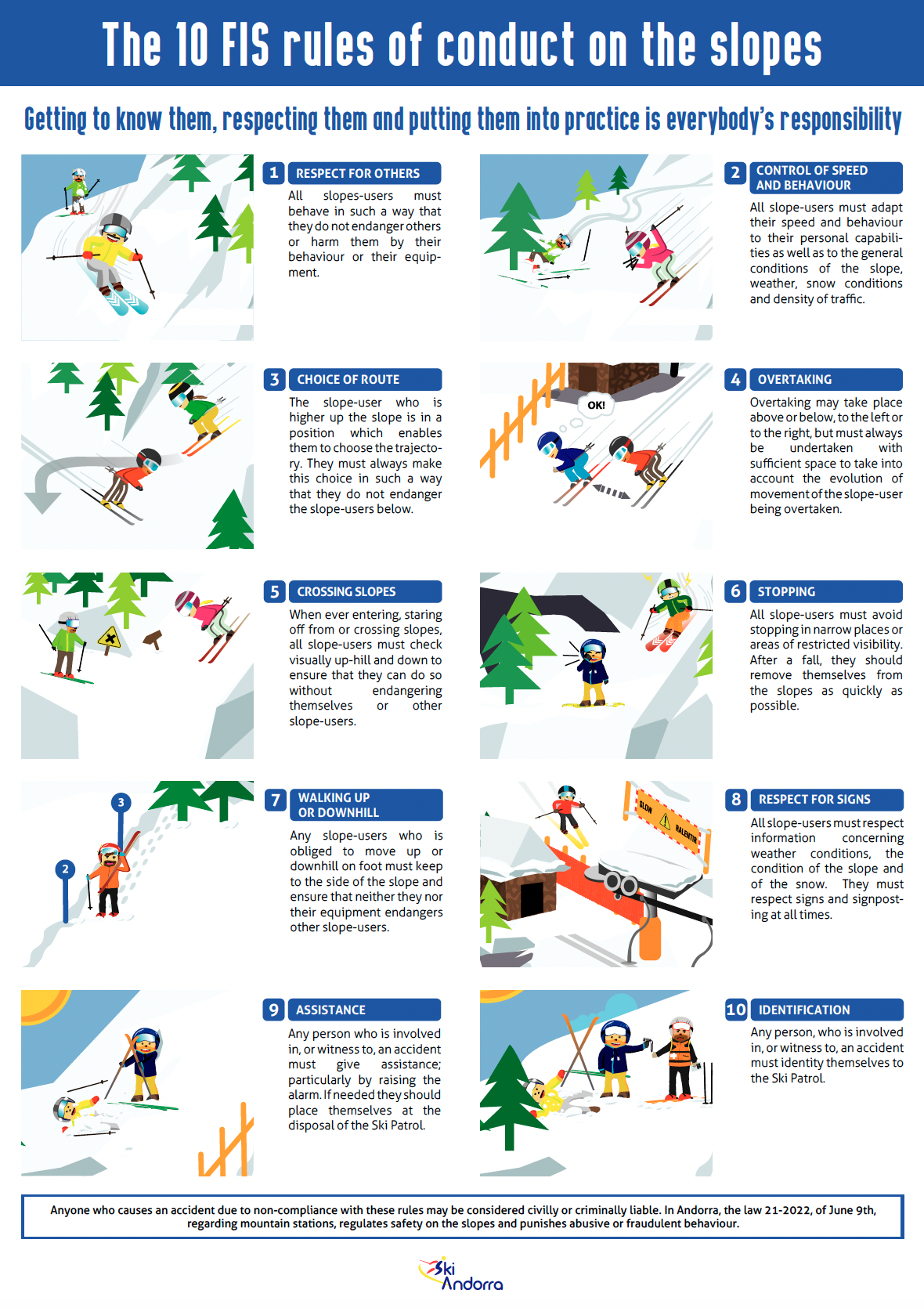Anterior
Siguiente
Safety regulations
Rules of conduct on the slopes
LEARNING THE 10 FIS RULES, RESPECTING THEM AND PUTTING THEM INTO PRACTICE IS EVERYBODYʼS RESPONSIBILITY
Anyone who causes an accident due to non-compliance with these rules may be considered civilly or criminally liable. In
Andorra, the law 21-2022, of June 9th, regarding mountain stations, regulates safety on the slopes and punishes
abusive or fraudulent behaviour.

1. Respect for others
A skier or snowboarder must behave in
such a way that he or she does not
endanger or harm others.

2.
Control Of Speed When Skiing Or Snowboarding
A skier or snowboarder must move with control. He or she must adapt their speed and manner of skiing or snowboarding to their personal ability and to the prevailing terrain, snow and weather, as well as to the amount of traffic.

3.
Choice of route
A skier or snowboarder coming from behind must choose their route in such a way that they do not endanger skiers or snowboarders ahead of them.

4.
Overtaking
A skier or snowboarder may overtake another skier or snowboarder above or below and to the right or to the left provided that they leave enough space for the overtaken skier or snowboarder to make any voluntary or involuntary movements.

5.
Entering, starting and moving upwards
A skier or snowboarder entering a marked
run, starting again after stopping or moving
upwards on the slopes must look up and
down the slope so that they do not
endanger themselves or others.

6.
Stopping on the piste
Unless absolutely necessary, a skier or
snowboarder must avoid stopping on the
piste in narrow places or where visibility is
restricted. After a fall in such a place, a
skier or snowboarder must move clear of
the piste as soon as possible.

7.
Climbing and descending on foot
A skier or snowboarder either climbing or
descending on foot must keep to the sides

8.
Respect for signs and markings
A skier or snowboarder must respect and
adhere to all signs and markings.

9.
Assistance
In case of an accident, every skier or
snowboarder is duty bound to assist.

10.
Identification
Every skier or snowboarder and
witness, whether a responsible party or
not, must exchange names and
addresses following an accident.
Learn how to use the ski lifts with skizz!

Respect the other skiers on the slopes
Control your speed and your trajectory on the slopes
Freestyle areas
Snowparks are reserved for practicing freestyle, a technique which requires you to use specific equipment for freestyle
skiing or snowboarding. For safety reasons, Snowblade® and Big Foot® will not be permitted it in the snowparks.
Inside the snowpark:
- Respect the signpostings. All snowparks have safety rules and regulations withwhich you must be familiar to guarantee your safety and other users.
- Respect the advice given by the staff responsible for the snowpark. Use a helmet and protective gear to prevent possible injuries in case of a collision or fall.
- Use a helmet and protective gear to prevent possible injuries in case of a collision or fall.
- Respect other users. Wait your turn and keep a safe distance. The modules are tobe used by one person at a time.
- Make sure that the landing area is free before each jump
- Respect the stopping points. If you want to take photos or videos, stop on one side or in a safe place, out of the way of modules. If you fall, get out of the landing area as quickly as possible.
- If you fall, try to get away from the reception area as quickly as possible.
- Do not jump next to the rail or boxes.
- Drones can not be used without prior permission from the ski stations.
- Choose your itinerary and obstacles according your level.
Off-piste
Only the opened slopes are patrolled, maintained and clearly marked. Skiing beyond these designated areas is
done at your own risk.
- Informa’t sobre el risc d’allaus a www.meteo.ad.
- In case of adverse weather conditions, you must know when to avoid off-piste skiing.
- First aid. Do not move the injured person! This must be done by a professional. The best thing you can do is to keep them company.
- Be sure that you are fully equipped, with an avalanche transceiver (DVA), probe and shovel.
- Do not ski off-piste alone. Even if you see ski tracks, this does not mean it is safe to ski in that area. Following ski tracks off-piste can lead to dangerous situations.
Download the app: it facilitates and speeds up a rescue if necessary.
In case of an accident
If, when you are skiing, you witness an accident, it is important to stay calm and act quickly and precisely:
- Protect the injured person.
- Alert the ski patrol service immediately. You can call the emergency telephone number that is indicated on the markers at the ski resort or notify the nearest staff member. Try to give them as many details as possible about the injured person and their location.
- First aid. Do not move the injured person! This must be done by a professional. The best thing you can do is to keep them company.

